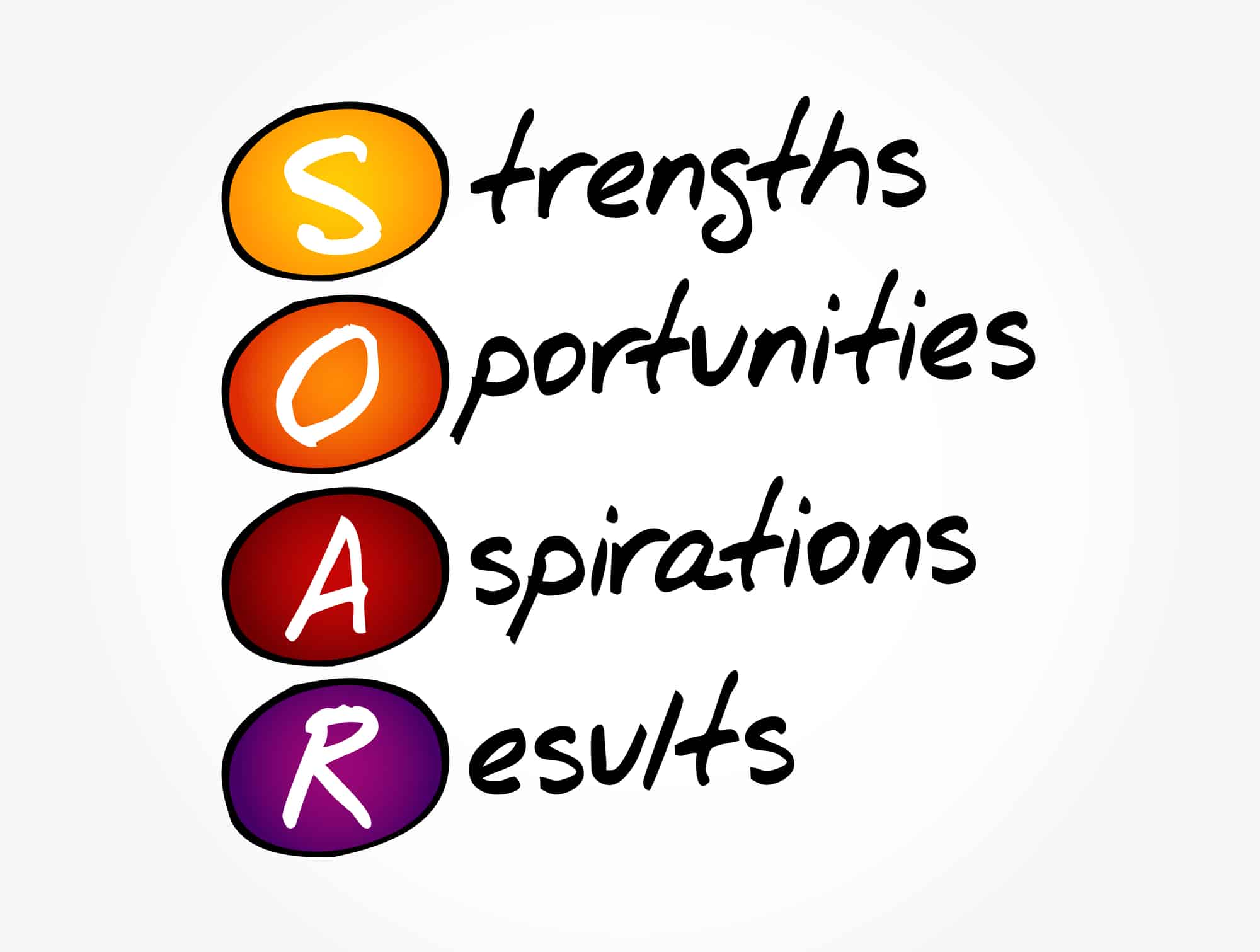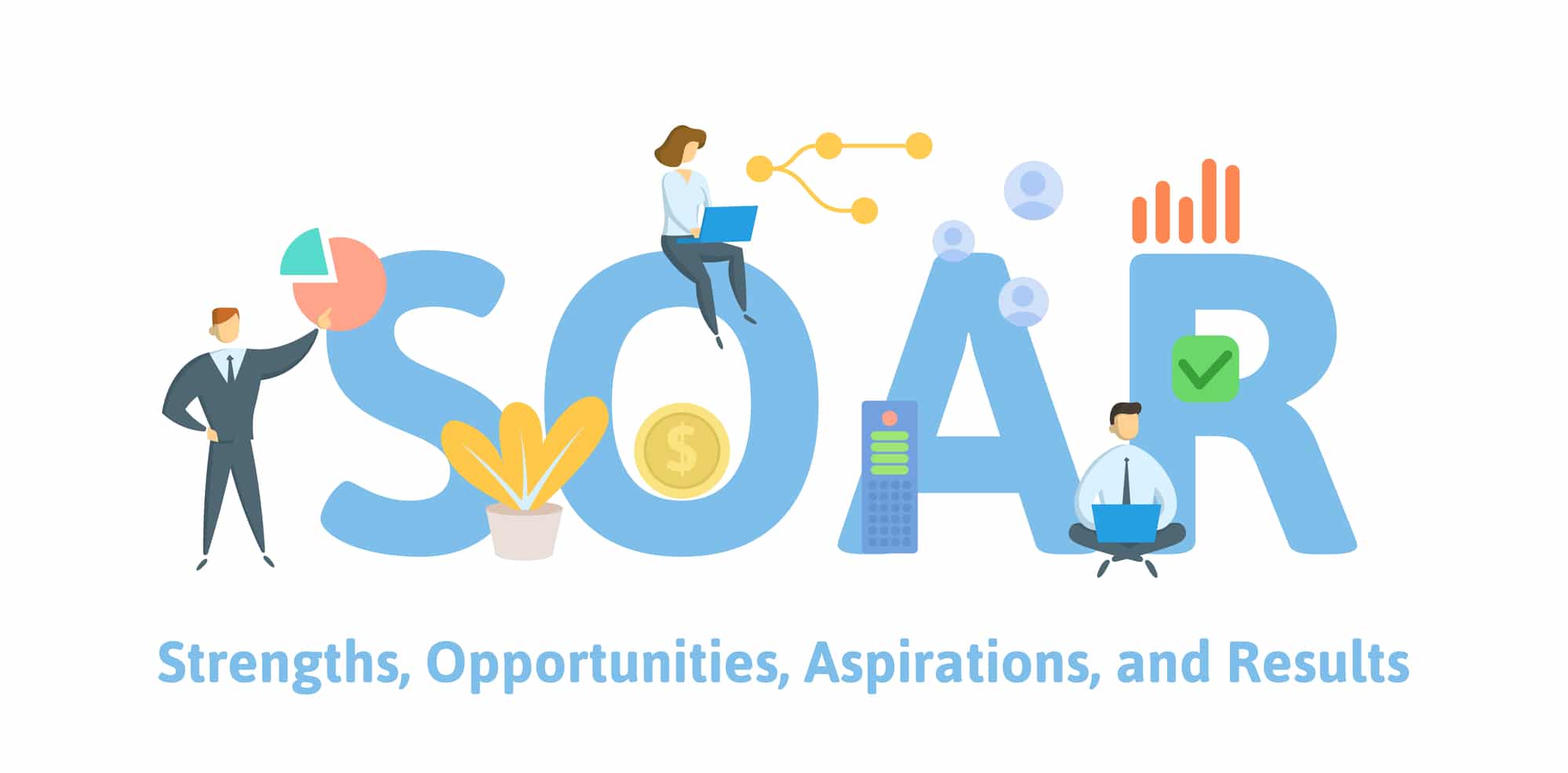What Is SOAR Analysis, how it's different than SWOT analysis, and how to do a SOAR analysis? Examining SOAR template's benefits and limitations with an example.
Judging by the fact that you have found your way to this article, chances are that you know a thing or two about strategic planning tools, or at least you want to. If that is the case, you must already be familiar with some essential strategic planning tools. This article will introduce you to yet another such tool, namely SOAR analysis.
For any organization to be successful, it must make efficient use of proper strategic planning. Contrary to its name, which seems rather complex, the strategic planning process is fairly simple, with a total of five steps that involve selecting specific goals and deciding on the ways to accomplish them.
The strategic planning process comprises five steps which include visioning, choosing goals, adding milestones, circumstance analysis, and revision, and a number of tools and techniques that can be applied on these components.
Certain tools and techniques can be specifically used for each step or even be applied to multiple steps. These tools include but are not limited to SWOT analysis, PEST analysis, scenario planning etc.
Some of these tools focus on both internal or external factors, while others focus primarily on external factors. For instance a SWOT analysis highlights both internal factors (strengths and weaknesses) and external factors (opportunities and threats). A PEST analysis is mostly concerned with external conditions such as economic or political factors.
On the other hand a SOAR analysis focuses mainly on the positives of a company’s situation, such as its strengths, opportunities, future goals, and the results they might bring forth. It is yet another tool that can also help organizations that want to come up with new ideas, generate effective strategies and revamp their business.
If you want to know about strategic planning in detail, you can always find helpful articles such as what is strategic planning?

What Is SOAR Analysis?
Simply put, a SOAR analysis is a strategic planning tool that allows organizations to formulate as well as execute effective strategies in order to achieve the goals that they have set for themselves.
This concept was first introduced in a paper published in 2003, titled SOAR: A New Approach to Strategic Planning, which was authored by Jacqueline Stavros, David Cooperrider & D. Lynn Kelley.
SOAR is an acronym that comprises four main elements, namely strengths, opportunities, aspirations and results. Therefore, this tool not only helps organizations figure out their current strengths and opportunities but also allows them to have a better idea of their future goals and the results they will eventually yield.
Furthermore, a SOAR analysis has a relatively diverse level of applicability as it can not only be used at any level within the organization but also outside the company’s defined boundaries. For instance, the internal target audience of a SOAR analysis may be the company’s employees, whereas the target outside the audience could be other stakeholders.
A SOAR analysis can not only help an organization to understand its current strengths but also highlights the skills that need to be improved upon. Moreover, this analysis can also provide valuable insights about what stakeholders want and how to motivate them to take desired actions that will benefit the company.
One of the main purposes of conducting a SOAR analysis is that organizations can find out what their strengths are. This allows them to focus on how to play to their strengths and achieve their goals instead of fretting over overcoming weaknesses.
Basically a SOAR analysis allows organizations to focus on their existing strengths that they can utilize to avail opportunities in pursuit of achieving the goals that they have set for themselves to bring about the desired results.
Moreover, this is the type of tool that is best used on a team or group level rather than an individual level.

What Is The Difference Between SWOT And SOAR Analysis?
While both SWOT and SOAR analysis are essentially tools used to aid an organization in its strategic process planning, they are not the same thing.
If you clicked through this article, chances are that you are already familiar with the concept of SWOT analysis. A SWOT analysis is a strategic planning tool used by organizations to analyze their internal (strengths, weaknesses) and external (opportunities and threats).
Hence a SWOT analysis focuses on both the positive and negative factors relevant to an organization. On the other hand, a SOAR analysis is more positively inclined, focusing only on a company’s strengths, the available opportunities, its future aspirations, and the achievement of desired results.
Moreover, while a SWOT analysis focuses more on the qualitative analysis of the four selected components rather than any results, a SOAR analysis is more action-oriented. It focuses on how strengths can be leveraged to avail opportunities and produce desired results that reflect the company’s goals.
In addition, contrary to a SWOT analysis that uses a to-down approach, a SOAR analysis is more diverse with its focus on all levels and functional areas of an organization.
Another factor that distinguishes the two types of tools is that while a SOAR analysis focuses on improving and enhancing what is already good, a SWOT analysis also focuses on the negatives. For instance, a SWOT analysis also highlights a company’s weaknesses and the threats that it may have to face.

Why Is SOAR Analysis Better Than SWOT?
While both SWOT and SOAR analysis are unique and serve organizations in their own way during the strategic planning process, some argue that one is perhaps better than the other.
The argument is usually in favor of the SOAR analysis rather than the SWOT analysis. One reason is that SOAR analysis focuses on the existing strengths or competencies a company already possesses and can leverage to avail market opportunities. This allows companies to achieve their goals and get their desired results.
Hence, while a SWOT analysis gives an idea of where a company is, a SOAR analysis takes a more futuristic approach and focuses on where a company can be.
On the other hand, a SWOT analysis also takes into account the weaknesses of or threats facing a company, i.e., negative factors that may either not occur or may not warrant as much attention as a SWOT would suggest.
Another reason for the SOAR analysis being preferred to a SWOT analysis is that unlike its counterpart, a SOAR analysis is action-oriented. While SWOT only focuses on analyzing the internal or external environment, a SOAR analysis is focused on obtaining results to achieve the company’s goals by utilizing its strengths to avail opportunities.

Why Do We Do SOAR Analysis?
The main purpose of carrying out a SOAR analysis is to unite all stakeholders so that together, they can realize the potential for the company and decide upon a shared vision based on which the organization will direct its efforts.
Moreover, the SOAR analysis tends to focus on the positive aspects of the organization and this concept aligns with the basic human preference for positive outcomes. Hence, employees or teams are more motivated to use this tool to make use of strengths in order to utilize opportunities and achieve results that are in line with the company’s future aspirations.
Furthermore, it can be used to explore new avenues, focus both resources and efforts on the areas that will yield the greatest advantage and best possible results.
Additionally, SOAR analysis has a vast range of applicability. It can be used by both new and existing businesses, within all industries and at any level within the organization.
Benefits of SOAR Analysis
Forward-Looking and Strength Focused
A significant benefit of SOAR analysis is that it is action driven and focuses on using current strengths to achieve future goals instead of utilizing limited resources on improving weaknesses.
Set Goals
Instead of simply analyzing a given situation or even generating results, a SOAR analysis uses a simple and structured format that helps companies actually set the targets or goals that they want to work towards achieving.
Tangible Goals
Instead of focusing on a purely qualitative analysis, SOAR analysis works towards achieving tangible and measurable results.
Guidance
Furthermore, SOAR analysis provides guidance for companies by allowing them to look towards the future and decide how they want to utilize their resources to achieve that future.
Simple and Easy
In addition to the above advantages, a SOAR analysis is relatively simple to understand and consequently easy to use.
Limitations of SOAR Analysis
Overlap
The aspiration component of the SOAR analysis may prove to be detrimental for companies that already have a predefined mission and vision. This analysis might derail the organization from its original direction, which is not always helpful.
Wrong Goals
Yet another disadvantage of SOAR analysis is that it only focuses on the positives (strengths and opportunities), wholly ignoring the negatives (weaknesses and threats).
Redundancy
Focusing on aspirations can also cause redundancy if the particular aspiration has already been stated in the company’s mission statement.
Wrong Focus
While a SOAR analysis highlights a company’s strengths, it does not provide an in-depth analysis of its customers or the relevant market place. This means there is a chance that the company may focus on the wrong area.
How To Do A SOAR Analysis?
A SOAR analysis yields the best results when performed by a group of people or stakeholders rather than a single individual. There are six basic steps involved in carrying out a SOAR analysis, namely, determine the objectives, create a team, brainstorming, pruning, executing, and monitoring.
Determining the Objectives
This step deals with the why, what, and when dimensions of the situation. Before an organization chooses to use a SOAR analysis for its strategic planning, it is essential for the company to know why it needs to use this tool in particular.
Moreover, in order for the company to have some sense of the direction that they want to proceed in, it must be clear about what it is that they want to achieve as a result of performing this particular analysis.
Lastly, as time is perhaps the scarcest of resources, it is imperative to set a fixed timeframe within which the desired results need to be achieved in order for them to be of some value to the organization.
Creating the Team
For this particular analysis, a team is the best way to go; the more, the merrier. This analysis requires a lot of observations and ideas, and who better to give them than the relevant stakeholders?
As has already been mentioned, a SOAR analysis can be applied to all functional levels of a company. So forming a team that includes individuals from all functional levels and taking key external stakeholders on board can result in various ideas.
One method to collect insights about the four elements of a SOAR analysis (strengths, opportunities, aspirations, results) is asking stakeholders to fill out a survey or form that presents their view on said components.
This examination of strengths and opportunities will present raw data that reflects the current state of the company. In contrast, the data about the aspirations and results will reflect the desired future state.
Brainstorming
The next logical step is to carry out a team brainstorming session based on the views generated in step two in order to come up with an initial draft for the SOAR analysis.
This will generate a rather generic result as a number of ideas are being brought together, keeping in mind the views of all relevant stakeholders.
Pruning
Because no organization has unlimited time or other resources,and ideas need to be actionable, the generic initial SOAR analysis needs to be narrowed down to reflect only the most important aspirations and consequent results.
The purpose of this stage is to decide and focus on only the essential opportunities that need to be pursued and invested in so that an action plan best suited to bridging the gap between the current and desired state can be devised accordingly.
Once the initial content has been narrowed down to bring forth a more specific picture, companies must create a captivating and adequately challenging vision (for the future). It is also essential to decide how the desired results will be measured.
Executing
Any planning activity is only as good as its execution. Carefully and effectively executing the complete and final SOAR analysis is the next logical step.
This can be done by assigning tasks to the right people, ensuring that only one person takes the final responsibility for each task.
Monitoring
If you think execution is the last step, think again. Now that things have been set into motion, it is important to monitor the progress to ensure that the desired results are achieved per expectations.

SOAR Analysis Template
The SOAR analysis can be represented in a quadrant where each of the four quadrants represents one alphabet of the acronym. The top row of the matrix presents the current facts of an organization, i.e., its strengths and weaknesses.
Whereas the second row presents the future state of the company, i.e., their aspirations and desired results.
Strengths
The first quadrant of the matrix represents the strengths of the company. I.e., the unique set of capabilities the organization already possesses and can use to get what it wants.
Strengths can be listed and include but are not limited to assets, resources, unique selling proposition and a company’s competitive advantage.
Opportunities
The second quadrant comprises opportunities that are external to the company. This component represents the situation or advantage available for a company that can be leveraged using the company's strengths to achieve the desired results.
A number of questions can be used by a company to identify the available opportunities for growth in its relevant market. For instance, a company can if any threats can be turned into opportunities. They can also observe the existing trends in their own market and the global market as a whole in order to identify opportunities to be leveraged.
They can also question gaps in the existing market especially with respect to customers' unfulfilled wants.
Aspirations
The third quadrant represents the aspirations or vision that is internal to the company. A company’s aspirations for the future are essentially the goals it wants to achieve. It is however, important to note that while some aspirations may coincide with an organization’s vision, they are not the same thing and hence should be treated as such.
Aspirations are often of a smaller scale and exist within a shorter timeframe than the company’s overall vision. These aspirations must be inspiring and challenging as well as meaningful. This is usually only possible when an organization possesses the desire to do better and be different.
A company can ask a number of questions to determine its aspirations. For instance, they can ask what they sincerely care about or how they can make a difference. Moreover, they can think about where they want their organization to stand at a certain point in time or what their goals should be.
Results
There is no point in pursuing aspirations if they cannot be measured because how else will an organization know if it is on the right track? Hence, the last quadrant of the matrix deals with desired results.
These results are measurable and quantifiable, which helps organizations realize if they are effectively utilizing their strengths to leverage opportunities and achieve their future aspirations.
A number of techniques can be used to set goals and measure results. These techniques include but are not limited to SMART goals, Outcome goals and the Balanced Scorecard technique.

SOAR Analysis Example
In order to better understand this concept, it would be best to make use of an example. Let’s take the example of the brand Philips.
Philips & Co is a Dutch company that was founded in 1891 by a father and son duo who recognized a need for the mass-market introduction of electricity, which brought about the concept of electric incandescent light bulbs.
Later on the company expanded into international markets and became known for its quality-driven innovations. Over the years, the company has developed a range of products, including video cassette recorder (VCR), compact discs (CD) etc.
These are just a few of Philips’ inventions and technological contributions and as such they warrant a closer look at the company.
Strengths
It is no wonder that a company of Philps standing would have a carefully curated set of strengths that it can employ at any point in time. These strengths include but are not limited to the following:
Innovation
The brand's greatest strength is also why it came into existence, its innovation-driven efforts and vision.
Philips has never shied away from coming up with and executing innovative ideas. This approach is one of its greatest assets that allows it to be one of the best companies within the ever-changing landscape of the technology industry.
Market Position
Another obvious strength for the company is its position as a market leader in the electronics and healthcare industry.
Loyal Customers
Moreover, the company’s loyal customer base provides it with the motivation to do better and the confidence that its innovative efforts will not only be recognized but also well received.
Global Network
The brand’s strong global network of manufacturing facilities and dealers is something to be envied and hence, a strength to be utilized.
These are just some of the strengths that Philips can further invest in and make use of in order to avail the existing market opportunities.
Opportunities
While there are a number of opportunities that Philips can avail, two opportunities are the exponential growth of the e-commerce sector as a result of the Covid-19 pandemic and the growth of the healthcare IT market.
Growth of E-Commerce Sector
The world saw an exponential increase in the electronic commerce sector due to the Covid-19 pandemic that prevented people from leaving their homes.
Philips, too, can gain from availing this particular opportunity to expand further and achieve its aspirations.
Healthcare IT Market Growth
The expansion of the healthcare IT market also serves as a lucrative opportunity for Philips as the brand is already serving this market and can further gain from its expansion.
Aspirations
In line with its vision and mission since its inception, Philips aspires to serve its customers through constant innovation.
Results
The company can use its innovation-driven approach, a global network of distributors, loyal customers, and market position to leverage the available opportunities. For instance, it can use these strengths to take advantage of the rise in e-commerce and growth in the healthcare IT market.
The brand has already set up its own website and is making efforts to attract people towards it. Its existing customers can help generate word of mouth and create a buzz about the brand on electronic forums.
Moreover, combining a global network of distributors with innovation efforts, Philips can leverage the growth of the e-commerce sector to achieve its aspiration of serving the global market with the most innovative products.
It can measure the results of these efforts using a number of tools, including statistics or sales information from its website, insights from distributors, and feedback from customers.

SOAR Analysis: Conclusion
To sum it up, companies that require a strategic planning tool that allows them to figure out their current strengths and opportunities but also allows them to have a better idea of their future goals and the desired results can make use of SOAR analysis.
Its diverse applicability and positive focus make it suitable for most organizations, especially smaller ones looking to grow by realizing and focusing on their strengths. This focus on the positive is one of the reasons that some companies prefer SOAR analysis to SWOT analysis.
Moreover, as with any strategic planning tool, SOAR analysis comes with its own set of benefits and limitations, as well as a series of steps that can be followed to carry out the analysis and generate templates.


